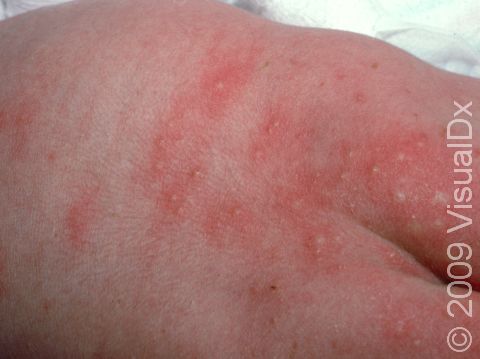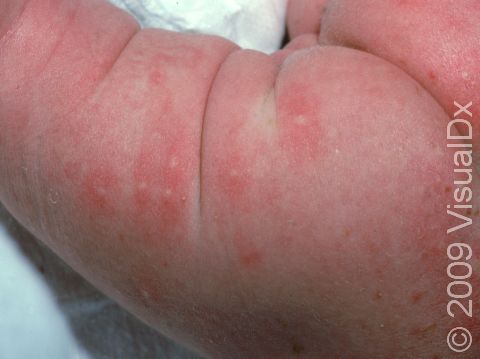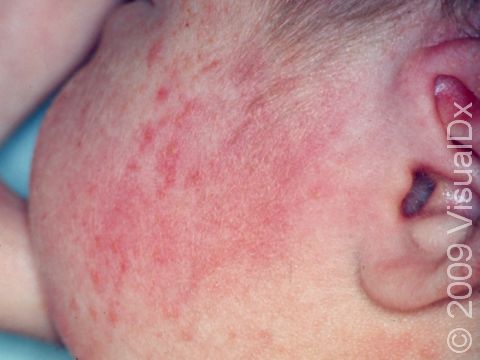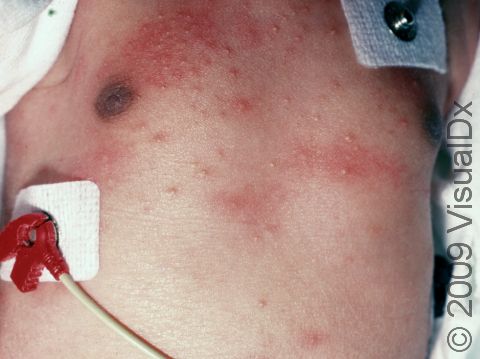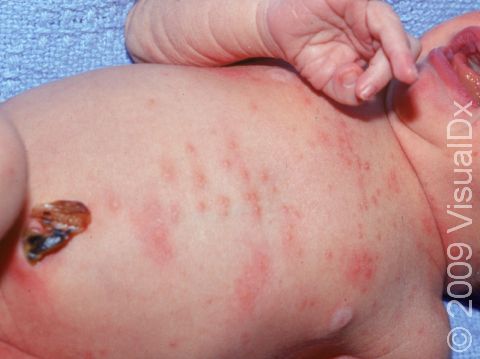Erythema Toxicum Neonatorum
Erythema toxicum neonatorum (also known as toxic erythema of the newborn) is a harmless red rash that appears on the skin of newborns. This rash goes away on its own and has no symptoms. It has often been likened to the appearance of a fleabite on the skin. Erythema toxicum is an extremely common rash that does not require any treatment, as it will spontaneously go away in 5–7 days. The cause of this rash is unknown.
Who's At Risk?
Approximately 50% of full-term newborns develop erythema toxicum shortly after birth, most commonly seen on the second day of life. Preterm infants are less commonly affected; however, they may develop erythema toxicum at a week of life. It is also uncommon in infants who weight less than 5.5 pounds at birth. The rash does not appear to be seen more often in any particular sex or race.
Signs & Symptoms
Erythema toxicum appears as small (1–3 mm), firm, yellow or white raised bumps filled with pus on top of a red area of skin. There may be a few to many lesions, and they may be found on any area of the body, with the exception of palms and soles. Erythema toxicum often begins on the face and spreads, and it may be clustered in areas where there is pressure on the skin. Although it most frequently appears during the first 3–4 days of life, erythema toxicum can be seen at birth and may not be present until 10 days of life. New lesions may appear as older ones resolve.
Self-Care Guidelines
There is nothing that needs to be done for this rash; it will resolve in a few days to a week. Do not pop the pus-filled bumps, as irritating the rash may lead to an infection.
Treatments
Your child’s pediatrician will likely not prescribe any medication for this skin condition. If the pediatrician is not certain about the diagnosis, he/she may take a sample of pus from the lesions and look at the cells under a microscope. This helps in making the diagnosis. Furthermore, a blood test to look for a certain population of cells (eosinophils) may aid in the diagnosis, although this is not a confirming test and not commonly done.
Visit Urgency
Because erythema toxicum occurs similar to many infectious disease rashes, including those caused by the herpes virus or other bacteria or fungi, if you are unsure, you should consult your infant’s pediatrician immediately.
Trusted Links
References
Behrman RE, Kliegman R, Jensen HB, eds. Nelson Textbook of Pediatrics. 18th ed. Philadelphia, PA: WB Saunders; 2007.
Habif, TP. Clinical Dermatology: A Color Guide to Diagnosis and Therapy. 4th ed. New York, NY: Mosby Inc; 2004.
Paller AS, Mancini AJ. Hurwitz Clinical Pediatric Dermatology: A Textbook of Skin Disorders of Childhood and Adolescence. Philadelphia, PA: Elsevier; 2005.
Zitelli BJ. Atlas of Pediatric Physical Diagnosis. Davis H, ed. New York, NY: Mosby Inc; 2007.
Last modified on October 5th, 2022 at 7:22 pm

Not sure what to look for?
Try our new Rash and Skin Condition Finder
